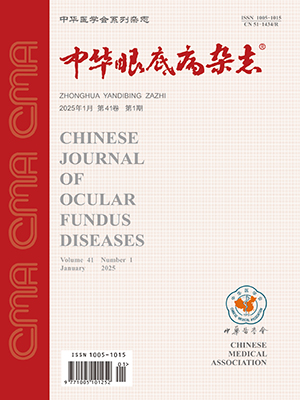| 1. |
Joachimiak E, Włoga D, Filipek A, et al. Ciliopaties-diseases caused by abnormal cilia functioning[J]. Postepy Biochem, 2018, 64(4): 338-350. DOI: 10.18388/pb.2018_148.
|
| 2. |
Reiter JF, Leroux MR. Genes and molecular pathways underpinning ciliopathies[J]. Nat Rev Mol Cell Biol, 2017, 18(9): 533-547. DOI: 10.1038/nrm.2017.60.
|
| 3. |
Lee JE, Gleeson JG. Cilia in the nervous system: linking cilia function and neurodevelopmental disorders[J]. Curr Opin Neurol, 2011, 24(2): 98-105. DOI: 10.1097/WCO.0b013e3283444d05.
|
| 4. |
Rao Damerla R, Gabriel GC, Li Y, et al. Role of cilia in structural birth defects: insights from ciliopathy mutant mouse models[J]. Birth Defects Res C Embryo Today, 2014, 102(2): 115-125. DOI: 10.1002/bdrc.21067.
|
| 5. |
Bujakowska KM, Liu Q, Pierce EA. Photoreceptor cilia and retinal ciliopathies[J/OL]. Cold Spring Harb Perspect Biol, 2017, 9(10): a028274[2017-10-03]. http://europepmc.org/article/MED/28289063. DOI: 10.1101/cshperspect.a028274.
|
| 6. |
Ramamurthy V, Cayouette M. Development and disease of the photoreceptor cilium[J]. Clin Genet, 2009, 76(2): 137-145. DOI: 10.1111/j.1399-0004.2009.01240.x.
|
| 7. |
Khanna H. Photoreceptor sensory cilium: traversing the ciliary gate[J]. Cells, 2015, 4(4): 674-686. DOI: 10.3390/cells4040674.
|
| 8. |
Wheway G, Parry DA, Johnson CA. The role of primary cilia in the development and disease of the retina[J]. Organogenesis, 2014, 10(1): 69-85. DOI: 10.4161/org.26710.
|
| 9. |
Estrada-Cuzcano A, Roepman R, Cremers F, et al. Non-syndromic retinal ciliopathies: translating gene discovery into therapy[J]. Hum Mol Genet, 2012, 21(R1): R111-R124. DOI: 10.1093/hmg/dds298.
|
| 10. |
He Y, Zhang Y, Su G, et al. Recent advances in treatment of retinitis pigmentosa[J]. Curr Stem Cell Res Ther, 2015, 10(3): 258-265. DOI: 10.2174/1574888x09666141027103552.
|
| 11. |
Takkar B, Bansal P, Venkatesh P. Leber's congenital cmaurosis and gene therapy[J]. Indian J Pediatr, 2018, 85(3): 237-242. DOI: 10.1007/s12098-017-2394-1.
|
| 12. |
Sheck L, Davies W, Moradi P, et al. Leber congenital amaurosis associated with mutations in CEP290, clinical phenotype, and natural history in preparation for trials of novel therapies[J]. Ophthalmology, 2018, 125(6): 894-903. DOI: 10.1016/j.ophtha.2017.12.013.
|
| 13. |
Tsang SH, Sharma T, et al. Progressive cone dystrophy and cone-rod dystrophy (XL, AD, and AR)[J]. Adv Exp Med Biol, 2018, 1085: 53-60. DOI: 10.1007/978-3-319-95046-4_12.
|
| 14. |
Braun DA, Hildebrandt Fl. Ciliopathies[J/OL]. Cold Spring Harb Perspect Biol, 2017, 9(3): a028191[2017-03-01]. http://europepmc.org/article/MED/27793968. DOI: 10.1101/cshperspect.a028191.
|
| 15. |
Zhang Q, Yu D, Seo S, et al. Intrinsic protein-protein interaction-mediated and chaperonin-assisted sequential assembly of stable bardet-biedl syndrome protein complex, the BBSome[J]. J Biol Chem, 2012, 287(24): 20625-20635. DOI: 10.1074/jbc.M112.341487.
|
| 16. |
Castro-Sánchez S, Álvarez-Satta M, Valverde D. Bardet-Biedl syndrome: a rare genetic disease[J]. J Pediatr Genet, 2013, 2(2): 77-83. DOI: 10.3233/PGE-13051.
|
| 17. |
Denniston AK, Beales PL, Tomlins PJ, et al. Evaluation of visual function and needs in adult patients with bardet-biedl syndrome[J]. Retina, 2014, 34(11): 2282-2289. DOI: 10.1097/IAE.0000000000000222.
|
| 18. |
Bonnet C, El-Amraoui A. Usher syndrome (sensorineural deafness and retinitis pigmentosa): pathogenesis, molecular diagnosis and therapeutic approaches[J]. Curr Opin Neurol, 2012, 25(1): 42-49. DOI: 10.1097/WCO.0b013e32834ef8b2.
|
| 19. |
Mathur P, Yang J. Usher syndrome: hearing loss, retinal degeneration and associated abnormalities[J]. Biochim Biophys Acta, 2015, 1852(3): 406-420. DOI: 10.1016/j.bbadis.2014.11.020.
|
| 20. |
Álvarez-Satta M, Castro-Sánchez S, Valverde D. Alström syndrome: current perspectives[J]. Appl Clin Genet, 2015, 8: 171-179. DOI: 10.2147/TACG.S56612.
|
| 21. |
Collin GB, Marshall JD, King BL, et al. The Alstrom syndrome protein, ALMS1, interacts with alpha-actinin and components of the endosome recycling pathway[J/OL]. PLoS One, 2012, 7(5): e37925[2012-05-31]. http://europepmc.org/article/MED/22693585. DOI: 10.1371/journal.pone.0037925.
|
| 22. |
Manara R, Citton V, Maffei P, et al. Degeneration and plasticity of the optic pathway in Alström syndrome[J]. AJNR Am J Neuroradiol, 2015, 36(1): 160-165. DOI: 10.3174/ajnr.A4115.
|
| 23. |
Lu Q, Insinna C, Ott C, et al. Early steps in primary ciliumassembly require EHD1/EHD3-dependent ciliary vesicle formation[J]. Nat Cell Biol, 2015, 17(3): 228-240. DOI: 10.1038/ncb3109.
|
| 24. |
Xu W, Jin M, Hu R, et al. The Joubert syndrome protein Inpp5e controls ciliogenesis by regulating phosphoinositides at the apical membrane[J]. J Am Soc Nephrol, 2017, 28(1): 118-129. DOI: 10.1681/ASN.2015080906.
|
| 25. |
Valente EM, Dallapiccola B, Bertini E. Joubert syndrome and related disorders[J]. Handb Clin Neurol, 2013, 113: 1879-1888. DOI: 10.1016/B978-0-444-59565-2.00058-7.
|
| 26. |
Szymanska K, Hartill V, Johnson CA. Unraveling the genetics of Joubert and Meckel-Gruber syndromes[J]. J Pediatr Genet, 2015, 3(2): 65-78. DOI: 10.3233/PGE-14090.
|
| 27. |
Zhang R, Chen S, Han P, et al. Whole exome sequencing identified a homozygous novel variant in CEP290 gene causes Meckel syndrome[J]. J Cell Mol Med, 2020, 24(2): 1906-1916. DOI: 10.1111/jcmm.14887.
|
| 28. |
Ronquillo CC, Bernstein PS, Baehr W. Senior-Loken syndrome: a syndromic form of retinal dystrophy associated with nephronophthisis[J]. Vis Res, 2012, 75: 88-97. DOI: 10.1016/j.visres.
|
| 29. |
Hemachandar R. Senior-loken syndrome-a ciliopathy[J/OL]. J Clin Diagn Res, 2014, 8(11): MD04-5[2014-11-20]. http://europepmc.org/article/MED/25584255. DOI: 10.7860/JCDR/2014/9688.5120.
|




